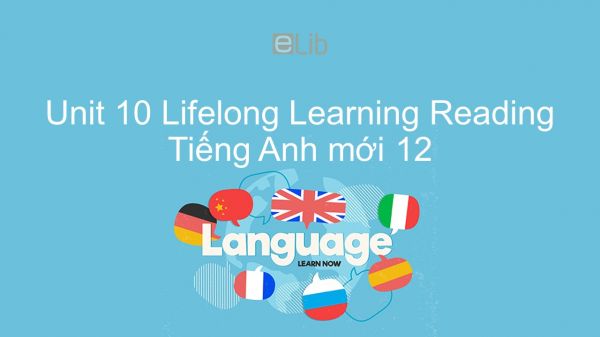Unit 10 lớp 12: Lifelong Learning - Reading
Bài học Unit 10 Lớp 12 mới phần Reading hướng dẫn các em đọc và tìm hiểu về một số lưu ý trong việc học tập cả đời. Thông qua một số dạng bài tập khác nhau, các em sẽ có cái nhìn khái quát về chủ đề này. Mời các em cùng tham khảo!
Mục lục nội dung

Unit 10 lớp 12: Lifelong Learning - Reading
Notes on lifelong learning (Chú ý về học tập suốt đời)
1. Task 1 Unit 10 lớp 12 Reading
Work with a partner. Ask and answer the questions below. (Làm việc với một người bạn. Hỏi và trả lời những câu hỏi phía dưới)
1. What do you think can facilitate lifelong learning?
(Bạn nghĩ gì có thể tạo điều kiện cho việc học suốt đời?)
2. How can people practise lifelong learning?
(Làm thế nào để người ta có thể học tập suốt đời?)
Guide to answer
1. The government's education policy and new technology are making lifelong learning more and more accessible.
(Chính sách giáo dục của chính phủ và công nghệ mới đang làm cho việc học tập suốt đời ngày càng dễ tiếp cận hơn.)
2. People can practise lifelong learning in many different ways, depending on their situation and circumstances. Some ways include courses, programmes, or talks at their workplace or at home.
(Mọi người có thể học tập suốt đời theo nhiều cách khác nhau, tùy thuộc vào hoàn cảnh và hoàn cảnh của họ. Một số cách bao gồm các khóa học, chương trình, hoặc nói chuyện tại nơi làm việc hoặc ở nhà.)
2. Task 2 Unit 10 lớp 12 Reading
Read the text about lifelong learning and choose a heading for each paragraph. (Đọc văn bản về học tập suốt đời và chọn một tiêu đề cho mỗi đoạn.)
a. Forms of lifelong learning (Hình thức học tập suốt đời)
b. Aims of lifelong learning (Mục đích học tập suốt đời)
c. Defining lifelong learning (Xác định học tập suốt đời)
d. The difference between compulsory education and lifelong learning (Sự khác biệt giữa giáo dục bắt buộc và học tập suốt đời)
Guide to answer
1-c. Defining lifelong learning
‘Lifelong learning’ is the pursuit of knowledge throughout life. In other words, learning is not confined to the classroom environment and school subjects. Instead, people can learn throughout their adulthood, even in old age and in a variety of situations, particularly in their daily interactions with others and with the world around them. Lifelong learning must be voluntary and self-motivated. Therefore, lifelong learners should have a strong desire to learn and explore the world.
2-a. Forms of lifelong learning
Lifelong learning is facilitated by e-learning platforms. Education is now no longer offered only by ‘bricks and mortar’ institutions. Online courses have instead enabled lifelong learning by providing learners, teachers, and course providers with much more flexibility in terms of learning time, place, pace, and style. Learners, for instance, can now have the course content taught to them by a school located miles away from where they live or work. In addition, young parents can select their group meeting time late in the evening when their children have gone to bed.
3-b. Aims of lifelong learning
Most importantly, lifelong learning should be regarded as an attitude to learning for self-improvement rather than a pathway to qualifications. This means the ultimate aim is to better yourself for personal and/or professional development rather than for some certificate to decorate your CV. This type of lifelong learning may not necessarily take place as part of a course. It may be done very informally in any area of interest and at your convenience, as long as it is well within your capabilities and/or improves your skills. For example, researching the tidal cycles of the sea where you often go fishing and the types of fish available there is a form of lifelong learning.
Tạm dịch:
1. Xác định học tập suốt đời
'Học tập suốt đời' là sự theo đuổi kiến thức suốt cuộc đời. Nói cách khác, học tập không giới hạn trong môi trường lớp học và các môn học của trường. Thay vào đó, mọi người có thể học hỏi từ bé đến khi trưởng thành, ngay cả ở tuổi già và trong nhiều tình huống khác nhau, đặc biệt trong giao tiếp hàng ngày của họ với người khác và với thế giới xung quanh. Học tập suốt đời phải là tự nguyện và có động lực. Do đó, những người học suốt đời nên có một ham muốn mạnh mẽ để học hỏi và khám phá thế giới.
2. Hình thức học tập suốt đời
Học tập suốt đời được tạo điều kiện bởi các nền tảng học tập điện tử . Giáo dục hiện nay không chỉ được cung cấp bởi các tổ chức 'gạch vữa'. Các khóa học trực tuyến thay vào đó cho phép học tập suốt đời bằng cách cung cấp cho học viên, giáo viên và nhà cung cấp khóa học linh hoạt hơn về thời gian, địa điểm, tốc độ và phong cách học tập. Ví dụ, những người học có thể có nội dung khóa học được giảng dạy bởi một trường nằm cách nơi họ sinh sống hoặc làm việc. Ngoài ra, các bậc cha mẹ trẻ có thể lựa chọn thời gian gặp mặt nhóm vào cuối buổi tối khi con cái họ đi ngủ.
3. Mục đích học tập suốt đời
Điều quan trọng nhất là học tập suốt đời nên được coi là một thái độ học tập để tự cải thiện chứ không phải là con đường đi đến bằng cấp. Điều này có nghĩa là mục tiêu cuối cùng của bạn tốt hơn cho sự phát triển cá nhân và / hoặc thông tin cho một số giấy chứng nhận trang trí CV của bạn. Loại học suốt đời này có thể không nhất thiết phải diễn ra như là một phần của khóa học, nó có thể được thực hiện rất không chính thức ở bất kỳ khu vực thú vị nào và thuận tiện với bạn, miễn là nó là tốt để phát triển khả năng của bạn và / hoặc cải thiện kĩ năng của bạn .Ví dụ , nghiên cứu các chu kỳ thủy triều của nơi bạn thường đi câu cá và các loại hình câu cá, đó là một hình thức học tập suốt đời.
3. Task 3 Unit 10 lớp 12 Reading
Read the text and find the words or phrases in the text that have the following meanings. Write them in the space below. (Đọc văn bản và tìm các từ hoặc cụm từ trong văn bản có ý nghĩa như sau. Viết chúng vào chỗ trống bên dưới.)
1. the action of trying one’s best to find or follow something...................
(hành động cố gắng hết sức để tìm hoặc theo đuổi một cái gì đó)
2. to keep someone or something within limits of time and boundaries of space..........................
(để giữ ai đó hoặc cái gì đó trong giới hạn của thời gian và ranh giới của không gian hạn chế.)
3. interactive online services that provide teachers and learners with information and tools..........
(các dịch vụ trực tuyến tương tác cung cấp cho giáo viên và người học các nền tảng học tập điện tử về thông tin và công cụ )
4. a building with physical presence rather than virtual or online..............................
(một tòa nhà có hiện diện vật lý hơn thực tế hay trực tuyến)
5. being or happening at the end of a process or a series of actions.........................
(đang xảy ra vào cuối một quá trình hoặc một loạt các hành động cuối cùng)
Guide to answer
1. pursuit (đuổi theo)
2. confine (giam giữ)
3. e-learning platform (giáo dục điện tử )
4. bricks and mortar (gạch và vữa)
5. ultimate (cuối cùng)
4. Task 4 Unit 10 lớp 12 Reading
Read the text again and answer the following questions. (Đọc lại văn bản và trả lời những câu hỏi bên dưới)
1. Which of the characteristics of lifelong learning distinguishes it from compulsory education?
(Những đặc điểm nào của học tập suốt đời phân biệt nó với giáo dục bắt buộc?)
2. What make people become good lifelong learners according to writer?
(Theo tác giả điều gì làm cho người ta trở thành những người học suốt đời tốt ?)
3. How is lifelong learning made possible or easier to access?
(Học tập suốt đời có thể dễ dàng truy cập hơn như thế nào?)
4. What should be objective of lifelong learning?
(Mục tiêu của việc học suốt đời là gì?)
Guide to answer
1. Lifelong learning is not confined to the classroom environment.
(Học tập suốt đời không giới hạn trong môi trường lớp học.)
2. Voluntary learning, self-motivation, and a strong desire to learn make people become good lifelong learners.
(Học tự nguyện, tự lực, và ham muốn học hỏi làm cho người ta trở thành những người học suốt đời tốt.)
3. Lifelong learning has been facilitated by e-learning platforms with a variety of online courses.
(Học tập suốt đời đã được tạo điều kiện bằng các nền tảng e-learning với nhiều khóa học trực tuyến.)
4. Lifelong learners should aim at learning for self-improvement, rather than as a pathway to qualifications.
(Các học viên suốt đời nên hướng đến việc tìm hiểu để tự cải thiện, chứ không phải là một con đường để đạt được bằng cấp.)
5. Task 5 Unit 10 lớp 12 Reading
Work in groups. Discuss the following question (Làm việc nhóm. Thảo luận câu hỏi sau)
Do you know someone who has kept learning throughout their life? Tell the group briefly about him/her.
(Bạn có biết ai đó đã kiên trì học tập trong suốt cuộc đời của họ? Nói cho nhóm một cách ngắn gọn về anh ấy / cô ấy.)
Guide to answer
Yes, I'll tell you about Ho Chi Minh President. He was a lifelong learner. He traveled more than 30 countries and could spoke more than 40 languages. He was always learning during his trip and found ways to save our countries. After gain independence, he still kept studying, and never stopped until he passed away.
(Vâng, tôi sẽ kể cho bạn nghe về Chủ tịch Hồ Chí Minh. Ông là một người học suốt đời. Người đã đi trên 30 quốc gia và có thể nói hơn 40 ngôn ngữ. Người luôn học hỏi trong chuyến đi của mình và tìm cách cứu nước mình. Sau khi đạt được sự độc lập, người vẫn tiếp tục học, và không bao giờ dừng lại cho đến khi người qua đời.)
6. Practice Task 1
Choose the letter A, B, C or D to answer these following questions
In developing countries, people are sometimes unaware of the importance of education, and there is economic pressure from those parents who prioritize their children's, making money in the short term over any long-term benefits of education. Recent studies on child labor and, poverty have suggested that when poor families reach a certain economic threshold where families are able to provide for their basic needs, parents return their children to school. This has been found to be true, once the threshold has been breached, even if the potential economic value of the children's work has increased since their return to school. Other problems are that teachers are often paid less than other professions; a lack of good universities and a low acceptance rate for good universities are evident in countries with a relatively high population density. India has launched EDUSAT, an education satellite that can reach remote parts of the country at a greatly reduced cost. There is also ail initiative supported by several major corporations to develop a $100 laptop. The laptops have been available since 2007. The laptops, sold at cost, will enable developing countries to give their children a digital education. In Africa, an "e-school program" has been launched to provide all 600,000 primary and high schools with computer equipment, learning materials and internet access within 10 years. Volunteer groups are working to give more individuals opportunity to receive education in developing countries through such programs as the Perpetual Education Fund. An International Development Agency project started with the support of American President Bill Clinton uses the Internet to allow co-operation by individuals on issues of social development.
Question 1: In developing countries, ________.
A. people all know that education is very important all the time
B. all parents are rich enough to send their children to school
C. children have rights to get high schooling
D. children have to work instead of going to school
Question 2: According to recent studies, when parents are able to overcome their financial difficulty, ________.
A. they send their children back to school
B. they still make their children continue working
C. they have their children work even harder
D. they themselves continue their schooling
Question 3: In populous countries, ________.
A. teaching is the highest-paid career
B. there are a lot of good universities
C. there is a lack of good universities
D. no other careers are better paid than teaching
Question 4: The third paragraph is about ________.
A. an Indian education satellite
B. the projects to computerize education in developing countries
C. the computerization of African education
D. President Bill Clinton who bought a lot of computers
Question 5: How many projects are presented in the third paragraph?
A. one B. two C. three D. four.
7. Practice Task 2
Choose the letter A, B, C or D to complete the passage below
Since China adopted its open-door (6) _____ approximately twenty-five years ago, Chinese higher education has begun once again to draw closer to the (7) _____ Western world. China's (3) _____ to send scholars and students to the United States at the end of the 1970s, after thirty years of hostility between the two countries, marked a dramatic turning (4) _____ in the nation's educational history. Today, about 50,000 Chinese students, are studying in the United States, accounting (5)_____ 10 percent of the total international students in the country.
Question 6: A. way B. law C. rule D. policy
Question 7: A. progress B. advanced C. head D. reach
Question 8: A. decide B. decisive C. decision D. decider
Question 9: A. point B. spot C. top D. stain
Question 10: A. for B. to C. up D. over
8. Conclusion
Kết thúc bài học, các em cần luyện tập đọc hiểu và ghi nhớ các từ vựng sau:
- pursuit (đuổi theo)
- confine (giam giữ)
- e-learning platform (giáo dục điện tử )
- bricks and mortar (gạch và vữa)
- ultimate (cuối cùng)
Tham khảo thêm
- doc Unit 10 lớp 12: Lifelong Learning - Getting Started
- doc Unit 10 lớp 12: Lifelong Learning - Language
- doc Unit 10 lớp 12: Lifelong Learning - Speaking
- doc Unit 10 lớp 12: Lifelong Learning - Listening
- doc Unit 10 lớp 12: Lifelong Learning - Writing
- doc Unit 10 lớp 12: Lifelong Learning - Communication and Culture
- doc Unit 10 lớp 12: Lifelong Learning - Looking Back
- doc Unit 10 lớp 12: Lifelong Learning - Project




